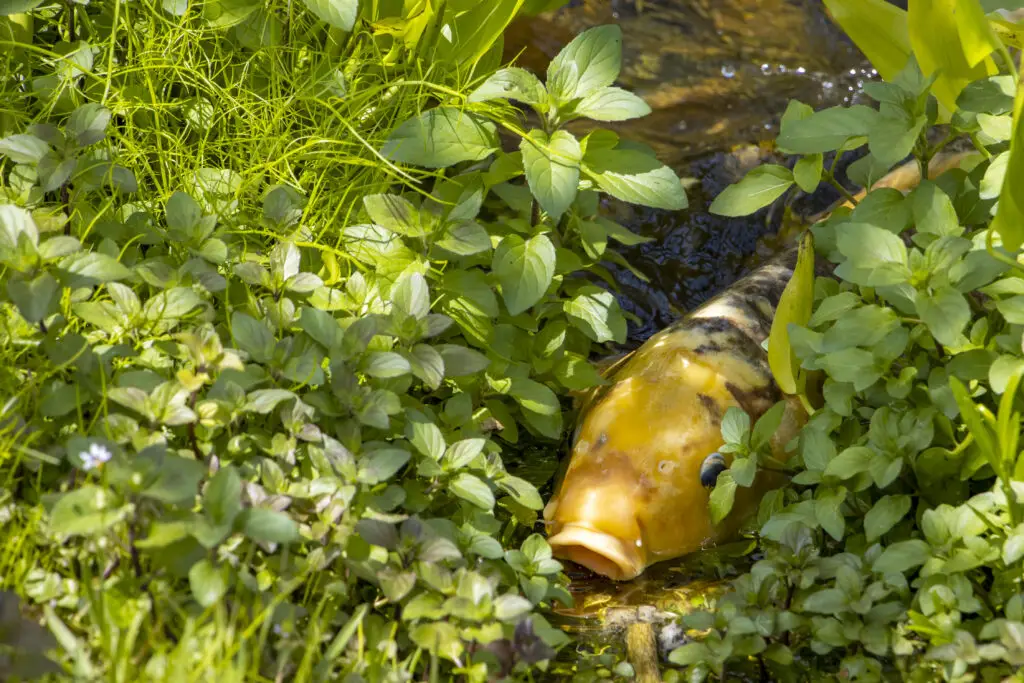
Koi fish can reach roughly 50 years (the oldest is estimated to be around 200 years old), provided they are cared for adequately. This care includes ensuring their ponds and water are clean and well-oxygenated, but what happens if your koi comes out of its pond? How long can koi live out of water?
Koi need water to survive; once removed from the water, they begin to deteriorate, and after thirty minutes to one hour of staying out of the water, the fish will perish. Certain factors contribute to the time a koi survives once taken out of the water, including temperature and gill moisture.
Although koi can stay out of water for around half an hour, it is not recommended that they do. The time spent out of the water causes severe stress to a koi’s organs. But how are koi able to stay out of the water at all? What are some factors influencing this duration? And why would a koi be out of water in the first place?
Pro Tip: If you’re tired of wasting money and making costly mistakes on the koi-keeping hobby or are thinking about buying koi fish but don’t know where to start, I strongly suggest you check out this ebook. I recently read this ebook, and it contains SO much useful information, such as:
- 3 proven steps to identify koi fish diseases
- WARNING: 3 things you should NEVER do when it comes to caring for koi
- When to seek professional help when it comes to looking after your koi
Why Can’t Koi Stay Out Of Water Indefinitely?
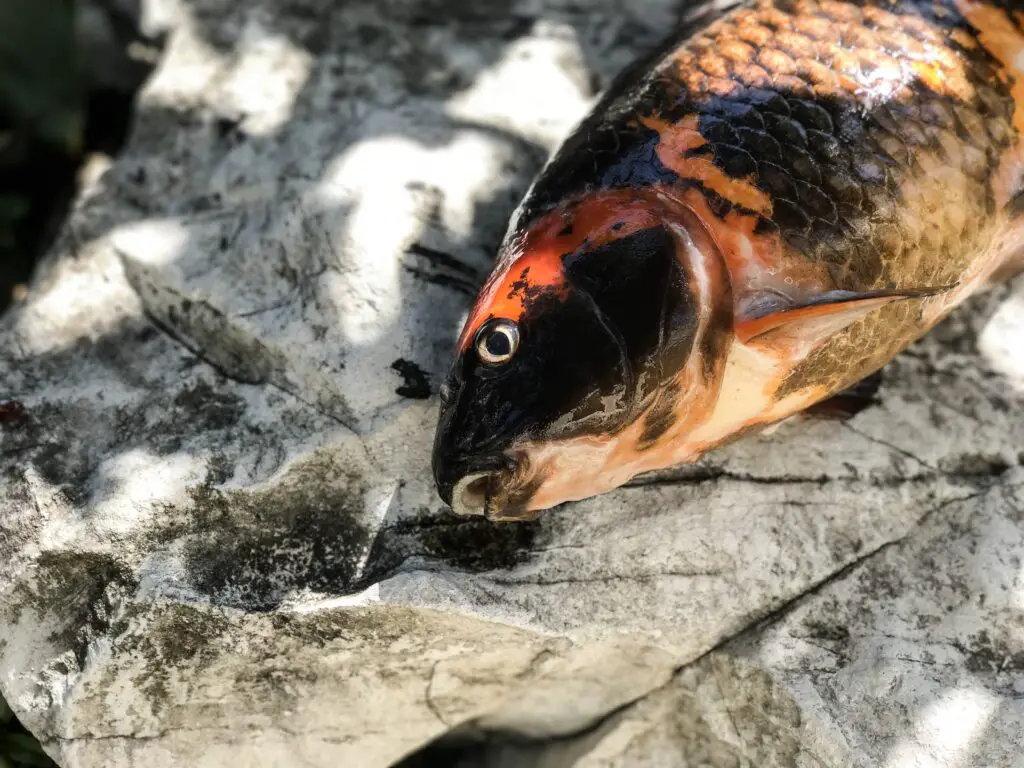
Fish require water to breathe. By passing water over their gills, fish extract the oxygen in the water through a gaseous exchange. Fish cannot draw oxygen from the air as we (and most other land-based creatures) do. Removing a fish from the water results in them suffocating to death.
Although the process of suffocating takes between a couple of minutes up to around an hour, there are severe consequences for removing a fish from the water for an extended period.
By starving a fish of oxygen, the fish’s body redirects oxygen to the critical organs. This prioritization results in shutting down organs deemed “less critical” for survival. So although the fish may resuscitate when placed back into the water (under very favorable circumstances), the fish likely suffered catastrophic organ damage, reducing its lifespan and quality of life.
A further issue with removing fish from the water for an extended time is that the mucous (slimy) secretions that cover their scales begin to evaporate/wear off. Once this mucous disappears, a fish’s scales and skin deteriorate.
Koi (and all fish, unless it’s a species that evolved the capacity to move on land) should not be removed from the water for any amount of time, if possible. If it is necessary to take them out of the water, you should remove them for very short intervals.
You should only remove a fish from the water for an extended time if you plan to eat it.
How Are Koi Able To Live Out Of Water?
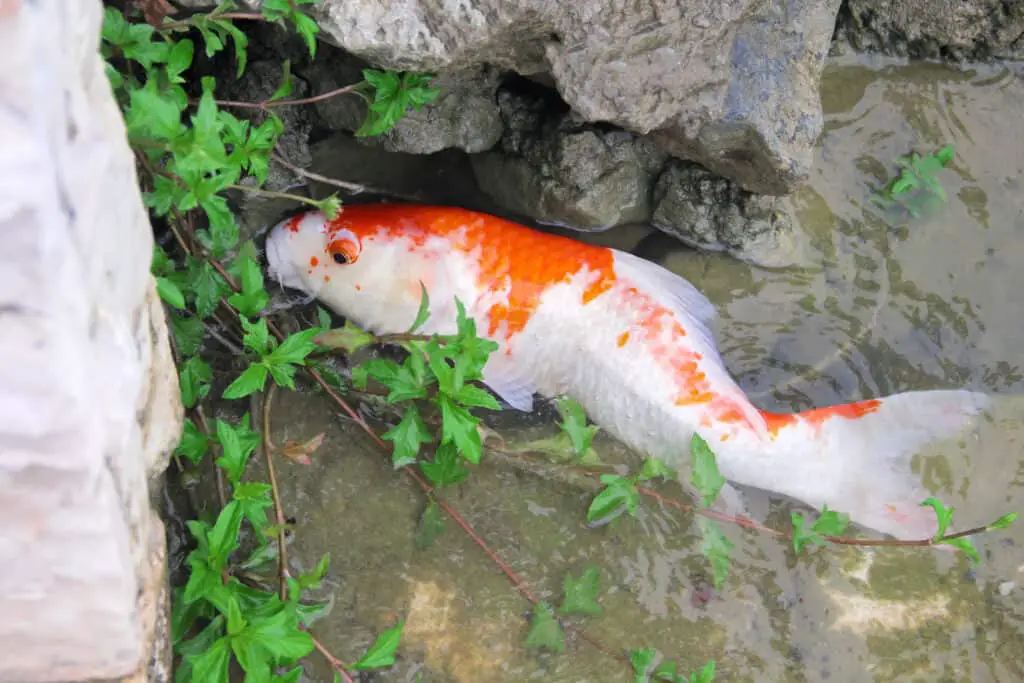
Although it is not ideal, koi can stay alive for around 30 minutes out of the water.
They can do this because their gills retain a small amount of water on and in them. This small volume of water is fundamentally a koi “holding its breath.”
A koi can pass this water over its gills for a short duration and still perform the gaseous exchange. However, the amount of oxygen absorbed from this water is limited, and the fish will struggle to breathe as time goes on.
Koi belong to the carp family of fish, a hardy group of fish. For this reason, they are also resilient enough to survive out of the water for longer than other delicate species.
Factors Influencing How Long A Koi Can Survive Out Of Water

Although half an hour is the average time a koi can survive out of the water, it is not always the case. Many factors delineate whether a “stranded” koi will survive for a longer or shorter period.
Some of these factors include:
Cold Vs. Hot Ambient Temperatures Determine The Time Frame
How cold or hot the ambient temperature is, plays a tremendous role in how a koi can survive out of the water.
The Effect Of Cold Ambient Temperatures On Stranded Fish
In colder conditions like winter or night, evaporation is slower (or non-existent). This lack of evaporation means that a stranded fish loses water at a slower rate and therefore has more water for respiration and water on their bodies which helps preserve the mucous layer.
Metabolic processes, respiration, and other bodily functions slow during colder conditions, which means less oxygen is required for survival and healthy organ functioning.
Colder weather places less stress on a stranded fish; fewer stress results in a fish that suffers less damaging effects. Often a koi will become stranded at night. In these situations, they may survive longer than during the day, as nighttime is usually cooler.
In extreme cases, like when it’s snowing, there is a potential for fish to freeze or approach a near-frozen state. Although not common with koi, other fish have survived these experiences, and, once thawed out, they make full (or mostly full) recoveries.
Several factors come into play with freezing and reviving. The freezing process must be almost instantaneous; otherwise, the fish will suffocate.
Although the survival out of water duration may be increased slightly during cold weather, it will only add minutes. Taking a fish (koi included) out of water for extended periods is not recommended.
There is a remarkable story of a koi owner who arrived home at 7 pm to find one of their koi fish barely alive. According to their home security footage, the koi had been out of the water since 3 pm, an astounding 4 hours!
The reputed reason for the koi’s stranding was a heron (a type of bird) that took the fish out and left it. The koi made a full recovery. During this ordeal, the ambient temperature was around 30 degrees Fahrenheit. However, this lengthy duration is not the norm but a rare spot of luck.
The Effect Of Hot Ambient Temperatures On Stranded Fish
Conversely, during hot ambient temperatures, a koi is in a greater state of shock/stress; it experiences greater evaporation levels (drying out), and its bodily functions operate faster than when it is cold.
During hotter temperatures, stranded koi will perish sooner. Those saved will generally have more severe consequences/health implications and may die later (their lifespans become shorter).
Depending on the temperature, koi may perish within minutes of leaving their water bodies.
Humid Vs. Dry Conditions Determine The Time Frame
Like temperatures influence the duration before a stranded koi perishes, how humid or dry an area is also plays a pivotal role.
In areas that experience higher humidity, a koi will have slightly more time before dying. Much the same as in colder temperatures, it would only be minutes.
In humid situations, evaporation is lessened, so a fish would have water on its gills for a slightly longer period before suffocating. Their scales would also remain “moist” for longer, which helps if you manage to get the fish back into the water.
In dry areas, a koi would perish slightly quicker as evaporation increases, making the water scarcer quicker. The faster-drying water also damages the koi’s scales by desiccating them.
The Size Of The Fish Determines The Survival Time Frame
External factors influence the duration a fish may survive out of the water, and so does the size of the fish. Larger fish survive longer out of the water than smaller fish.
The rationale is that larger fish have a greater gill surface area, meaning they can draw in more oxygen per breath. Larger fish have stronger gills (they can “pull” water more effectively) and lose water less quickly than smaller fish.
How Wet The Gills Are When They Are Out Of The Water
There are stories about archaic peoples moving koi fish’s predecessors across Asia in wet baskets or ice containers. These stories may contain an element of truth. When kept moist, a koi should survive for a longer time. This duration depends on if enough water is in contact with the koi’s gills.
Although it might be possible to move fish this way, it is not recommended. The fish struggles to draw oxygen from the limited water and may experience the effects of oxygen starvation (like organ failure and reduced lifespan).
With all the mentioned variables, the amount of water/moisture a koi has on its gills determines survival. The more water on a koi’s gills, the more gaseous transfer occurs, and the longer a koi (and other fish) will live.
Reasons For When You Should Take A Koi Out Of Water
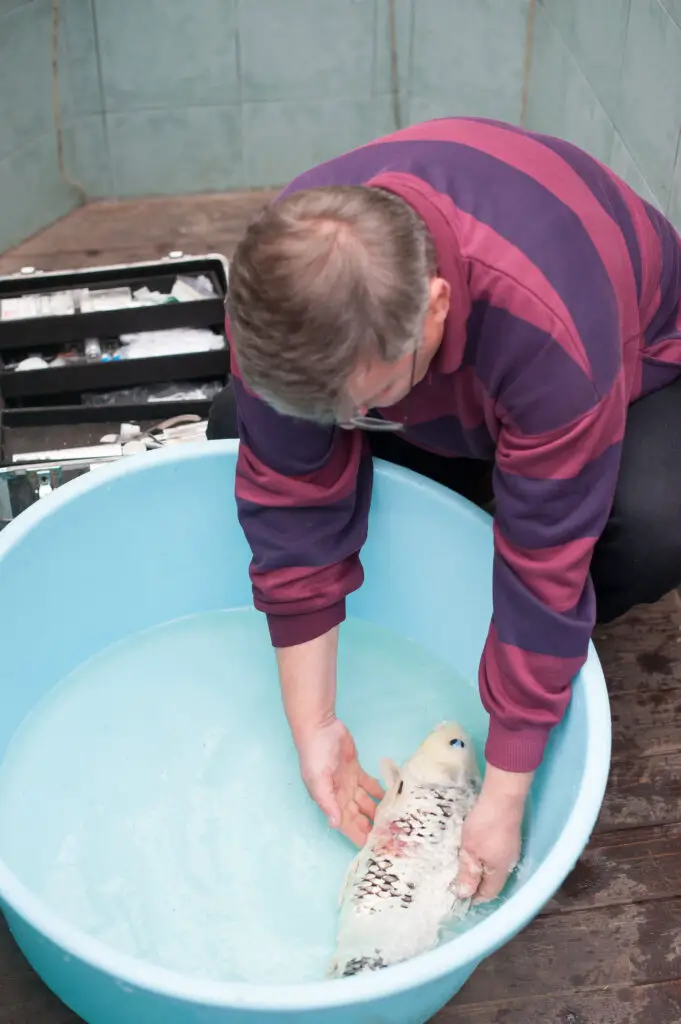
Koi and most other fish species should be removed from the water as little as possible. You must do so as quickly as possible when removing a fish. Fish out of the water for extended periods become stressed and suffer organ failure, oxygen depletion, and, ultimately, death.
Some of the reasons for removing a fish from water include:
● Transportation. If you purchase a new fish, it must leave the holding tank and enter a transport tank/vessel. Moving from one water source to the next is often very quick, and no issues develop.
● Cleaning your koi pond. Hygiene is critical when keeping fish, so you may need to remove koi from their pond. Once again, koi should immediately go into a temporary vessel/water body that is sufficiently sized with oxygenated water.
● Examine the koi for health issues. Sometimes koi contract external parasites. You must take the koi out of the water to examine and remove the parasites. This process needs to be as quick as possible and, if need be, should be broken up into shorter duration endeavors to ensure the koi’s well-being.
How Long Should A Koi Be Kept Out Of Water For?
Although koi kept under moist conditions should survive for extended periods out of the water, removing them from the water is not recommended. Koi begin to suffocate almost as soon as they are removed.
Although a level of moisture on their gills allows them to breathe, it is not enough to sustain them sufficiently, and they will experience issues.
When working with your koi, you should immediately take them from one water body to the next (when the need arises). When removing ectoparasites from koi, using a net is recommended, and keeping the koi semi-submerged.
This partial water state is better for the koi’s health than removing them from the water completely for any period.
How Can You Tell A Koi Has Been Out Of Water For Too Long?
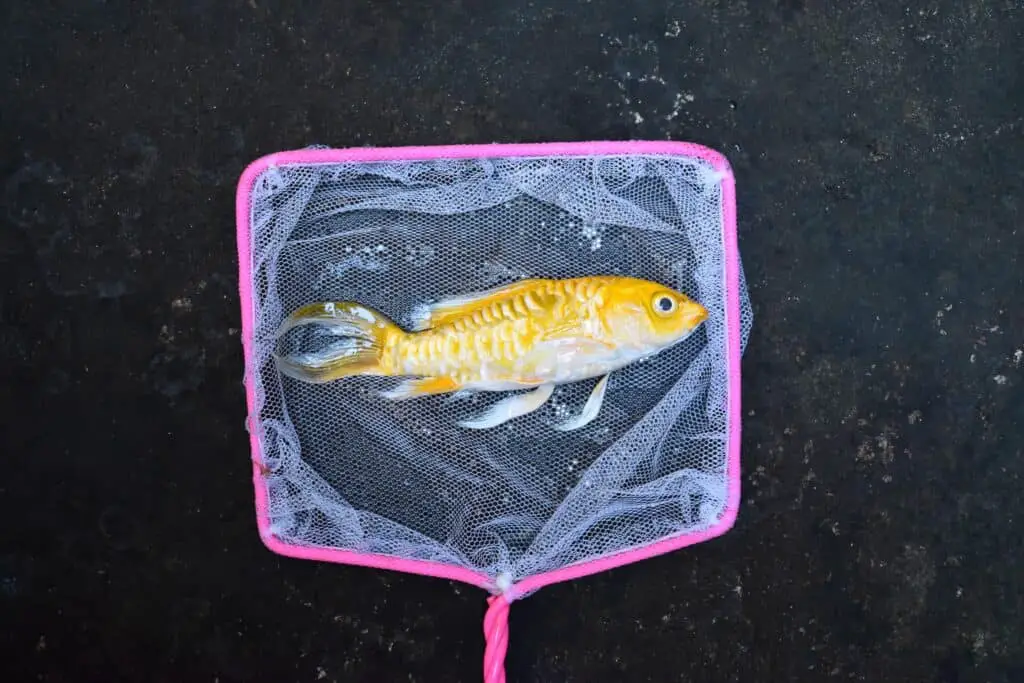

Sometimes, koi end up out of their ponds against our control. Things like jumping, a feature koi are well known for, predators pulling them out, overfilling koi ponds, and many other examples could result in your koi becoming stranded.
Can You Save A Koi Fish That Has Been Out Of The Water For Too Long?
If you arrive to find your koi out of the water, it is important not to give up hope. The koi may yet be saved. To determine whether a koi is “salvageable” or not, you need to look at the following:
The Duration The Koi Was Out Of The Water For
Although not always the “final authority,” when a koi ends up out of the water, a guideline as to whether it will survive is the duration it was out of the water for. If the koi were stranded for less than 30 minutes, there is a good chance it would make it.
Depending on various environmental and fish variables, up to an hour could still be okay.
How Dry And Stiff Is The Fish?
When a koi ends up stranded, it will dry out and become stiff to the touch as time progresses. If the fish is hard and dry, the chance of surviving is not very high.
If, however, the koi is still damp and relatively soft, resuscitation might be possible.
Look For Signs Of Life
If your koi is in the process of flapping around on the ground, the chances are it has recently come out of the water. Things like flopping, tail swishing, gill movements, gaping, or even eye movements are signs that the fish is alive and may still have some fight.
Try And Resuscitate Before Giving Up
When in doubt, try and resuscitate the koi. You never know; it may surprise you.
Place the fish in the water and hold it upright. Try to open the mouth by placing your finger under its mouth at the back, then gently squeeze. The idea is to simulate water flowing through its mouth and out of its gills.
If Your Koi Jumped Out Of Its Pond, Can You Still Put It Back?
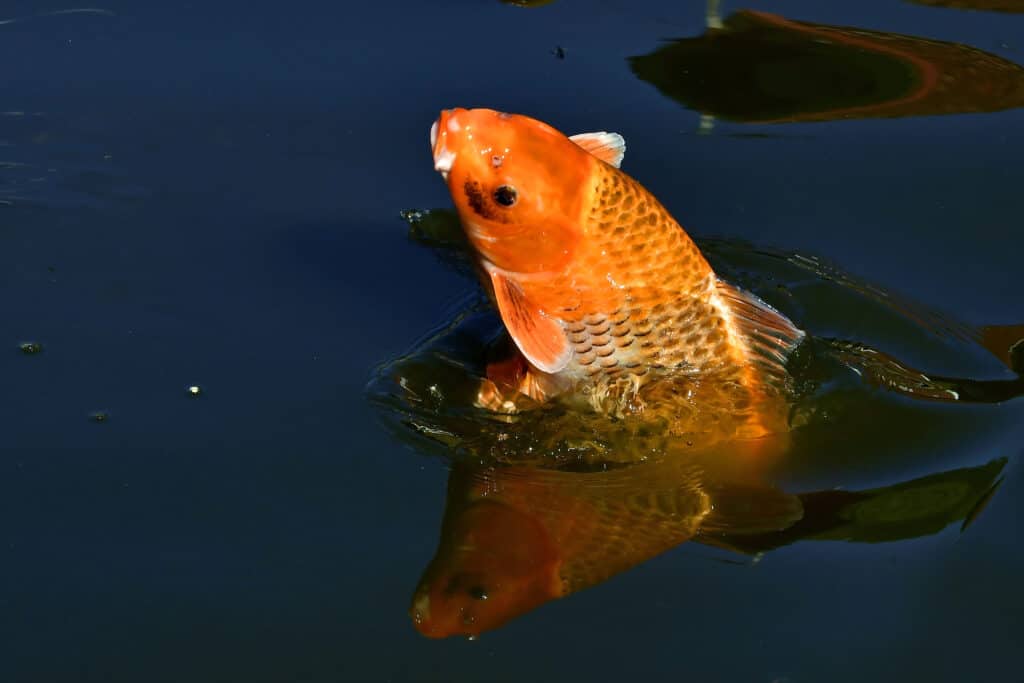
Depending on how long your koi was out of the pond will determine if it is worth returning to the pond. My suggestion would be to try and resuscitate the fish in the closest water body, which often is the pond. If your fish revives, keep an eye on it over the next few days.
How Long Can A Koi Survive In Low Oxygen Conditions?
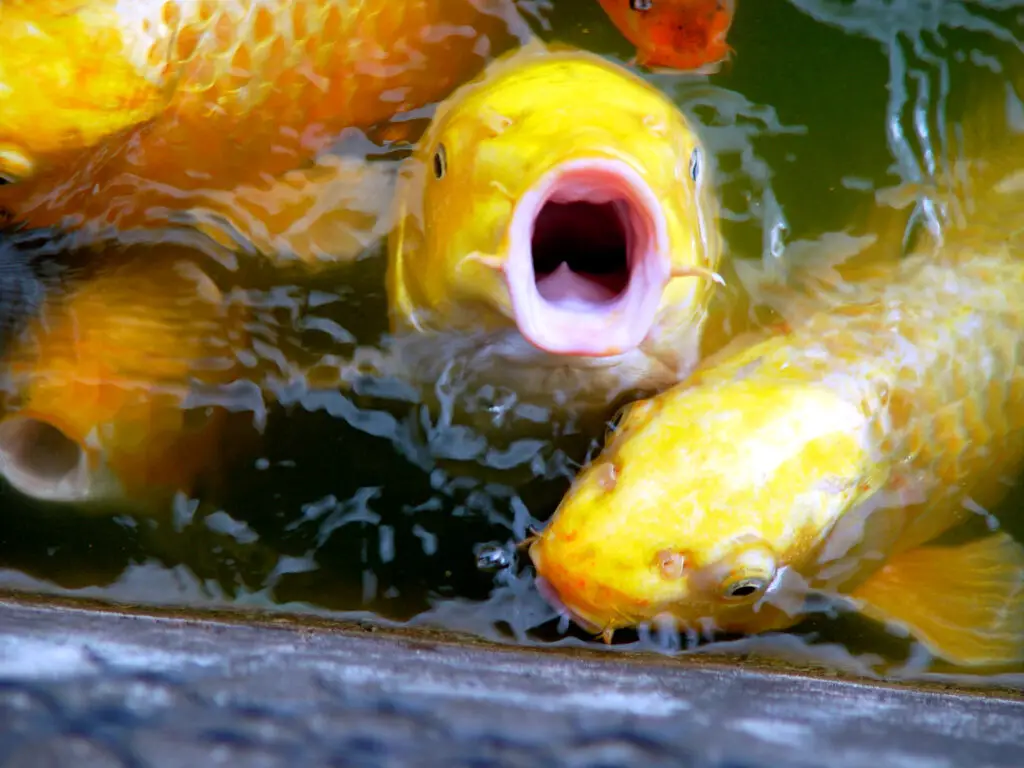
Sometimes koi do not even need to leave the water to suffocate.
Koi require dissolved oxygen in their ponds. A minimum amount of 8 parts per million (ppm) is recommended. Anything less than this, and koi may begin to jump out of the pond.
Another sure sign of oxygen shortages in the pond is when koi breach the surface gasping for air.
If oxygen levels are too low, koi could suffocate/drown and perish within minutes. A well-aerated pond is critical for a koi’s survival.
Conclusion
Like most other fish, koi must stay in the water to “breathe.” While out of the water, koi could live for a couple of minutes up to roughly one hour. The total survival duration depends on several things, like temperature, humidity, and what the koi are kept in. The best action plan is to keep your koi in the water to avoid stress for you and the fish.
Sources
https://www.answers.com/Q/How_long_can_koi_fish_live_out_of_water

